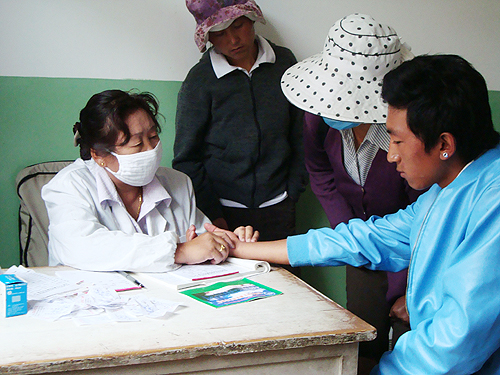|
 |
|
FEELING A CURE: A doctor in the Tibetan Medicine Hospital of the Tibet Autonomous Region feels the pulse of a patient (YUAN YUAN) |
The Tibetan Medicine Hospital of the Tibet Autonomous Region, in downtown Lhasa, is packed with patients from Monday to Friday.
"All the doctors in this hospital are of the Tibetan ethnic group," said Tsewang Tanpa, director of the hospital's outpatient administrative office. "We accept about 800 patients every day. Around 70 or 80 percent of Tibetans would choose here as their first choice for treatment."
Tibetan medicine, with a more than 2,000-year history, has developed from the experiences and wisdom of people on the plateau. During the third century B.C., a primitive medical system formed on the Qinghai-Tibet Plateau. It provided instructions for daily life, including what to eat and drink, and prescribed simple therapies such as using butter to stop bleeding, bloodletting and massage.
"Tibetan medicine dictates that diseases are caused by the influence of the environment, climate and diet," said Tsewang. "Doctors normally first instruct the patients to change living habits or diet instead of giving prescriptions."
Diseases can be categorized into two types, cold or hot. Medicine is used to "cool the hot" and "warm the cold."
"Tibetan medicine offers patients different prescriptions for the three different times of a day, since each herb has its best time when it will have the maximum effect," said Tsewang.
Just as traditional Chinese medicine (TCM) is based on the theory of the balance between yin and yang, Tibetan medicine also has a balance, but it uses three instead of two. Nyima Cering, a doctor at the hospital, said these three elements are Long, Chiba and Peigen. Long refers to the energy of the human body, which is similar to what is described in TCM as qi. Chiba refers to the body's liquids, including the saliva, blood, sweat and bile. Peigen is the functioning of the internal organs.
Tibetan medicine also uses feeling the pulse as one+ of the methods of diagnosis. Practitioners also pay special attention to the change of the tongue's coating and the first urine discharge in the morning.
"We don't test the chemical elements in the urine. Our diagnosis is based on observing it with the naked eye. We look for the color of the urine and whether there are some impurities in it. Different colors and impurities hint at different diseases," said Nyima. "This method has proven to be right in the long history of the medicine."
Tibetan doctors now use modern equipment like x-ray equipment, endoscopes, and ultrasonic devices along with traditional methods to improve the accuracy of the diagnosis.
The most unique aspect of Tibetan medicine might be the processing method of the materials.
"We can put minerals in the medicine, including gold, silver, bronze and iron, which are supposed to be highly poisonous," said Gonggar Norbu, Director of the Tibetan Medicine Production Factory, which is located in Lhasa. Between 10 and 20 percent of the medicine produced by the factory contains the minerals. A secret processing method, which is called zuotai in Tibetan, removes the poisonous elements from the minerals.
Isolated by the high altitude, living habits, history and culture, traditional Tibetan medicine had long been kept separate from the outside world. It has long been regarded as the third choice after Western medicine and TCM. This has proven to be the main obstacle in marketing Tibetan medicine.
"People living in other places normally know very little about Tibetan medicine," said Gonggar. "The first Tibetan medicine brand, Ganlu, which was created by our factory, was only accepted by the State Administration for Industry and Commerce in 2004."
The factory's 2004 profits amounted to only 2.3 million yuan ($336,800). But in 2008, they increased to more than 7 million yuan ($1.02 million). The company produces medicine called 72-ingredient Pearls and 25-ingredient Pearl Pills for treating heart and brain diseases and disorders.
The company organized a group of Tibetan doctors to offer free medical consultations around China. "Everywhere we went, many patients came to us, some with chronic diseases. They saw very good results with the Tibetan medicine treatments," said Gonggar.
Now, there are 18 Tibetan medicine-producing factories in Tibet and the market has spread to many countries in Asia, including Mongolia, Indonesia, Thailand, Nepal and Myanmar.
"But we still can't enter the European market due to different medicine testing standards," said Gonggar.
In China, at least 10 cities in the interior have set up Tibetan medicine centers. One of the largest is the Beijing Hospital of Traditional Tibetan Medicine, which was founded in 1992.
Gonggar said he is planning to introduce more information about the health-preserving functions of Tibetan medicine to the other parts of China as a next step to popularizing the treatments.
"I've been to many Chinese cities where some shops have opened to sell Tibetan medicine," said Gonggar. | 